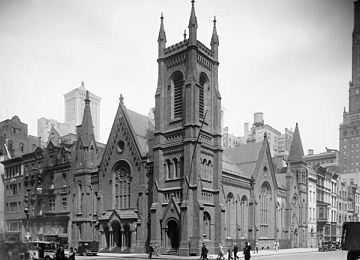
Blog
Our Place
in the Story
By Timothy Keller
I recently read Matthew Bowman’s The Urban Pulpit: New York City and the Fate of Liberal Evangelicalism (Oxford, 2014). The book recounts that the original established churches of New York were the Dutch Reformed and Anglican churches. Then the evangelical awakening, spearheaded by George Whitefield and others in the late 1730’s and 40’s, emphasized the importance of a conversion experience through hearing the gospel proclaimed.
Though the older churches rejected Whitefield and the evangelical idea of the need for conversion, the new Presbyterian congregations were opened to him. Over the course of the 18th century, led by the ministers John Gano of First Baptist and John Rodgers of First Presbyterian, these two denominations embraced evangelical ministry and grew and flourished more than other denominations. First Presbyterian planted Brick, Cedar Street (later Fifth Ave), and Rutgers Presbyterian. First Baptist also saw many new Baptist churches begun around the city. By the first half of the 1800’s, evangelical Christianity was the “cultural consensus” and had come to “cultural dominance” in the New York (p. 33-34.) The Fulton Street revival of 1857-1859 may have been its high tide.
After this, however, Protestant churches began to face a fast-rising population of poor and Catholic residents, especially in Lower Manhattan. There, Protestant churches found their attendances quickly dwindling. Their ministries assumed that non-Christians would be culturally Protestant, that they would view their church as a place they ought to be, and would understand the sermons preached. But now they were surrounded by people who would not darken the Protestants’ doors, and found much of what was said incomprehensible.
Bowman also observes that by the 1880’s, New York City was becoming the first commercial urban capital, so filled with restaurants, stores, and theaters that simply walking, shopping, and eating became a past-time in itself (pp. 43, 155-165). This damaged the attractive reach of the church, which had always relied on being the main form of communal eating, music, gathering, and instruction in society, drawing the neighbors in to hear the Word preached. Now all these supportive social structures had been superceded.
How did the Protestant churches respond? At first they simply moved from the more multi-ethnic, commercialized areas to residential, Protestant parts of the city nearer Central Park. Another strategy was to erect enormous, stately, beautiful buildings and sanctuaries, seeking to draw people in and assert their presence in the public space from which they felt expelled (pp. 53-84.) None of these things stopped the decline.
Finally Bowman traces out how the crisis split the church. Slowly but surely some began to move away from a confidence in preaching and in the transmission of teaching and truth to bring about conversion. At the more scholarly level figures like Charles A. Briggs of Union Theological Seminary taught that the Bible contained errors, that only the main story-lines of the Bible were God’s Word, that human reason and experience had to guide us rather than only the Scripture. To appeal to the modern person, it was argued, we had to abandon the belief that the Bible was completely truthful and the key to all life-change.
At the practical level, Presbyterian ministers like Henry Van Dyke at Brick Presbyterian sought to change people through the arts and the aesthetic experience, while Henry Sloan Coffin at Madison Avenue Presbyterian pioneered the full-service church that provided social and educational services. Bowman writes: “If redemption had come by hearing for generations of evangelicals since the Reformation, in New York City ... it would now come through doing.” (p. 112) Rather than try to convert people through changing their beliefs, the churches sought to make people followers of Christ through loving action, social reform, and education.
The other reaction to the secularizing city was taken by the Baptists. While Presbyterians and others moved toward what would be called Liberalism, Baptists moved toward what came to be called Fundamentalism. I. M. Haldeman, who pastored First Baptist for almost 50 years and John Roach Straton of Calvary Baptist developed a very combative stance toward the city. Fundamentalist preaching also moved away from historic preaching because it began to focus much more on materialism and moral evils such as drinking and sexual promiscuity. To show how these two pathways diverged more and more, Bowman has two concluding chapters, one on the fundamentalist Straton and one on the liberal Harry Emerson Fosdick, who was the first pastor of Riverside Church.
In a short newsletter article it is impossible to avoid over-generalization. Yet it is hard not to see that by the second half of the 20th century, the older kind of Protestant evangelicalism—true to historic orthodox doctrine, yet also intellectually robust and socially engaged—was weak or vanished in New York City. And now it is growing back. There are at least a 100 churches that we can discern that have been begun over the last 20 years in center city New York (and some older churches renewed) that are closer to the older kind of Christianity that used to flourish here. However, we too face the issue of a culture that is not interested in what we have to say. How do we reach them?
We must not make the same mistake again. We must not respond with either withdrawal nor with assimilation to the spirit of the age.
